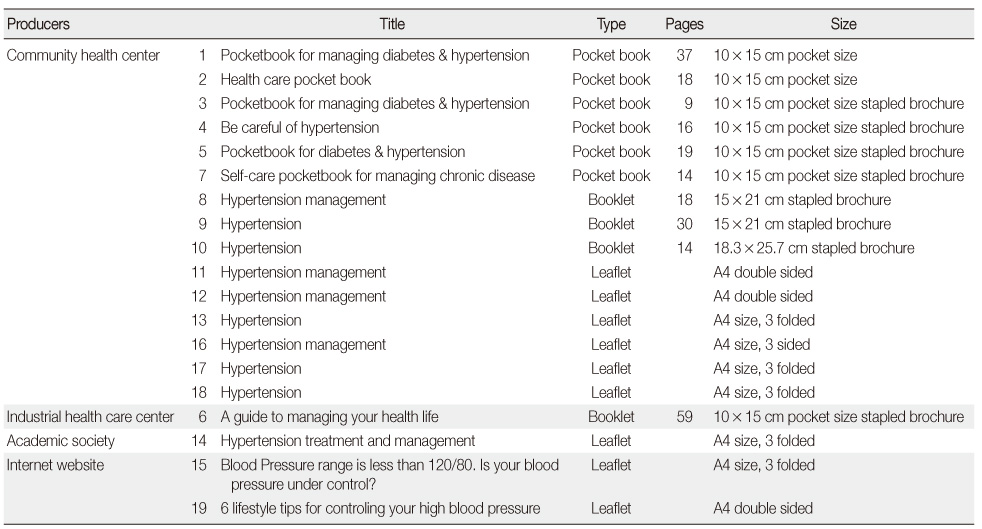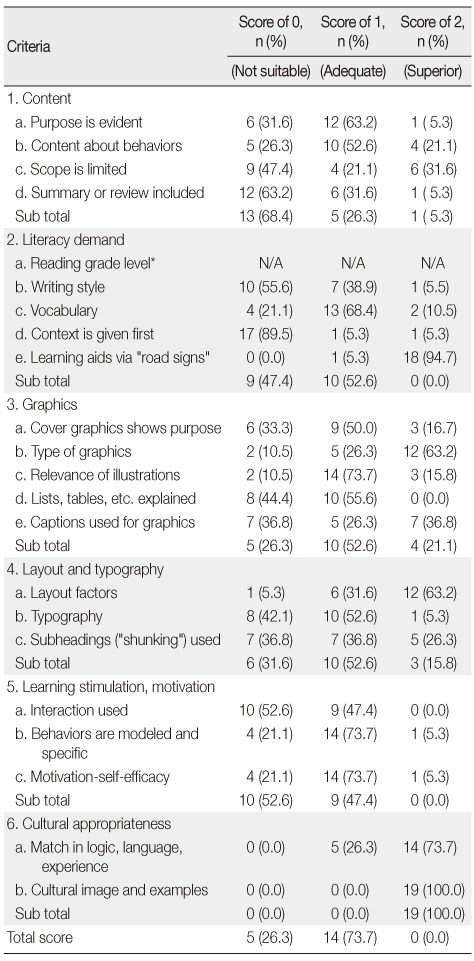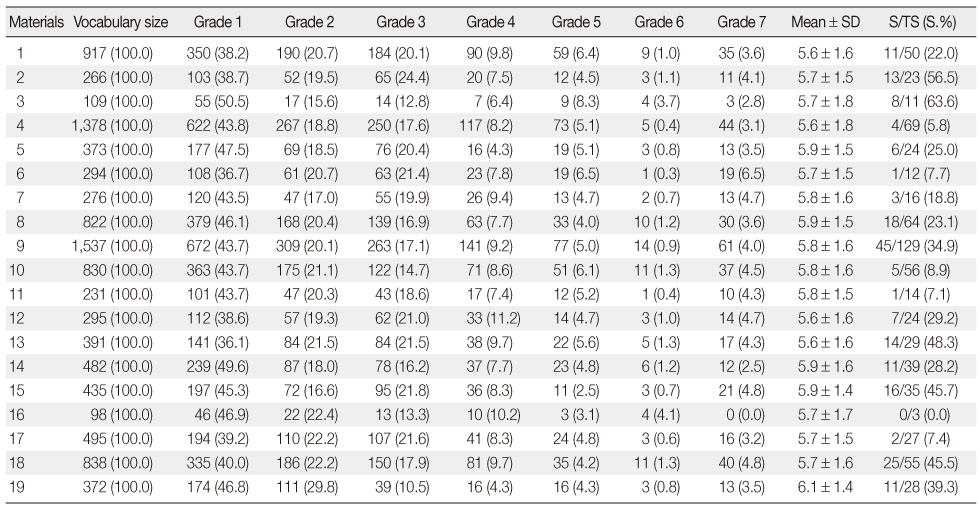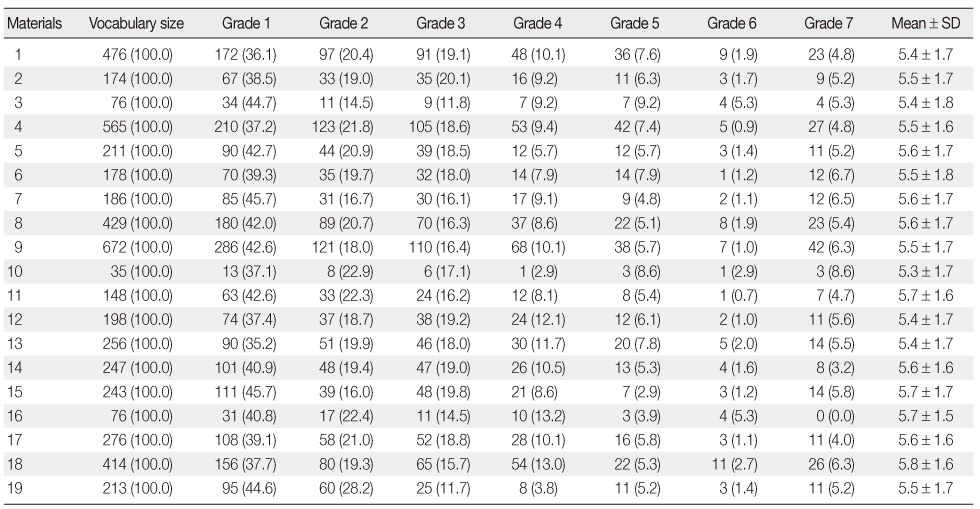Articles
- Page Path
- HOME > J Korean Acad Nurs > Volume 41(3); 2011 > Article
-
Original Article
- Suitability and Readability Assessment of Printed Educational Materials on Hypertension
- Tae Wha Lee, Soo Jin Kang, Hye Hyun Kim, So Ra Woo, Sinhye Kim
-
Journal of Korean Academy of Nursing 2011;41(3):333-343.
DOI: https://doi.org/10.4040/jkan.2011.41.3.333
Published online: June 13, 2011
1Professor, College of Nursing, Nursing Policy Research Institute Yonsei University, Seoul, Korea.
2Doctoral Candidate, Graduate School of Yonsei University, Seoul, Korea.
3Full-time Lecturer, Armed Forces Nursing Academy, Daejeon, Korea.
4Nurse, MSN, Severance Hospital, Seoul, Korea.
5Master's Student, Graduate School of Yonsei University, Seoul, Korea.
- Address reprint requests to: Kang, Soo Jin. College of Nursing, Yonsei University, 250 Seongsan-ro, Seodaemun-gu, Seoul 120-752, Korea. Tel: +82-2-2228-3305, Fax: +82-2-392-5440, soojin@yonsei.ac.kr
© 2011 Korean Society of Nursing Science
Abstract
-
Purpose
- The aim of this study was to assess the suitability and readability of printed educational materials for patients with hypertension in Korea.
-
Methods
- A total of 33 written educational materials related to hypertension were collected from public health centers, hospitals, and internet web site. Among them, we analyzed 19 materials which fit the inclusion criteria: leaflets (n=9), booklets (n=3), and guide book (n=7). Two trained nurses evaluate the materials using suitability assessment tool (SAM; Doak, Doak, & Root, 1996a) and graded lexical items for teaching Korean (Kim, 2003).
-
Results
- Overall, 14 (73.7%) of 19 materials scored adequate, and 5 (26.3%) scored inadequate. On the average, the education materials contained 36.1% to 50.5% of 1st grade reading level words and 12.9% to 21.6% of 4th grade level and over.
-
Conclusion
- The reading level of the materials was higher than a 6th grade reading level. It is proposed that the written educational materials should be developed by health professionals according to suitability and quality by taking the target group's literacy capacity into consideration.
This work was supported by the National Research Foundation of Korea (NRF) grant funded by the Korea government (MEST). (No.2009-0053325).
- 1. Bernier MJ, Yasko J. Designing and evaluating printed education materials: Model and instrument development. Patient Education and Counselling. 1991;18:253–263. doi:10.1016/0738-3991(91)90134-q.Article
- 2. Bodenheimer T, Lorig K, Holman H, Grumbach K. Patient self-management of chronic disease in primary care. Journal of the American Medical Association. 2002;288:2469–2475. doi:10.1001/jama.288.19.2469.ArticlePubMed
- 3. Choe IS. A comparative study on modelling readability formulas: Focus on primary and secondary textbooks. Journal of Korean Society of Information Management. 2005;22:173–195. doi:10.3743/KOSIM.2005.22.4.173.Article
- 4. Doak CC, Doak LG, Root JH. Teaching patients with low literacy skills. 1996a;2nd ed. Philadelphia, PA, JB Lippincott Company.
- 5. Doak LG, Doak CC, Meade CD. Strategies to improve cancer education materials. Oncology Nursing Forum. 1996b;23:1305–1312.PubMed
- 6. Flesch R. A new readability yardstick. Journal of Applied Psychology. 1948;32:221–233. doi:10.1037/h0057532.ArticlePubMed
- 7. Fry E. A readability formula that saves time. Journal of Reading. 1968;11:513–578.
- 8. Helen O. Health literacy from A to Z: Practical ways to communicate your health. 2004;Boston, MA, Jones and Bartlett Publishers.
- 9. Hoffmann T, Worrall L. Designing effective written health education materials: Considerations for health professionals. Disability and Rehabilitation. 2004;26:1166–1173. doi:10.1080/09638280410001724816.ArticlePubMed
- 10. Kim GH. The graded lexical items for teaching Korean. 2003;Seoul, PJ book.
- 11. Kim SY, Park YW, Shin HC, Kim CH, Sung EJ, Lee SH. Readability of patient information on hypertension in Korea. Journal of the Korean Academy of Family Medicine. 2007;28:346–351.
- 12. Korean thesaurus. Korean Language Education Research Institute. 2009;Retrieved October 19, 2009. from http://www.natmal.com.
- 13. Lee KW. Rho MW, Park YM. Understanding comprehension process and communication of context. In: Literacy Education. 2008;Seoul, Hankukmunhwasa. 332–354.
- 14. McLaughlin GH. SMOG grading a new readability formula. Journal of Reading. 1969;12:639–646.
- 15. National Institute of the Korean Language. Literacy in Korea (No. 2008-1-57). 2008;Seoul, Author.
- 16. Standard Korean language dictionary. National Institute of the Korean Language. 2009;Retrieved September 5, 2009. from http://stdweb2.korean.go.kr.
- 17. Park SM, Jung HS, Kim YK, Lee YJ. Study on the way of the occupational health care management for foreign workers. 2007;Seoul, Federation of Korean Trade Union.
- 18. Park SY. Comparison of readabilities of 6th grade science and social studies textbook. 2009;Jeonju, Jeonju National University of Education. Unpublished master's thesis.
- 19. Scott A. Managing anxiety in ICU patients: The role of pre-operative information provision. Nursing in Critical Care. 2004;9:72–79. doi:10.1111/j.1478-5153.2004.00053.x.ArticlePubMed
- 20. Seol DH, Hong SK, Goh HU, Kim IT. A research on the health care of foreign workers. 2005;Seoul, Korea Foundation for International Healthcare.
- 21. Shieh C, Hosie B. Printed health information materials; Evaluation of readability and suitability. Journal of Community Health Nursing. 2008;25:73–90. doi:10.1080/07370010802017083.ArticlePubMed
- 22. Shin HC. The evaluation of patient educational materials. Journal of the Korean Academy of Family Medicine. 2000;21:S318–S321.
- 23. Song JM. A study on the readability of elementary school science textbooks. 2010;Jeonju, Jeonju National University of Education. Unpublished master's thesis.
- 24. Sung NJ, Lee DU, Park KH. Suitability assessment of patient's education materials made by Korean academy of family medicine. Journal of the Korean Academy of Family Medicine. 2004;25:669–677.
- 25. Literacy and health outcomes (AHRQ publication No. 04-E007-2). U.S. Department of Health and Human Service, Agency for Healthcare Research and Quality. 2004;Retrieved September 9, 2009. from http://www.ncbi.nlm.nih.gov/books/NBK37134.
- 26. Health literacy universal precautions toolkit (AHRQ publication No. 10-0046-EF). U.S. Department of Health and Human Service, Agency for Healthcare Research and Quality. 2010;Retrieved April 4, 2010. from http://www.ahrq.gov/qual/literacy.
- 27. Vallance JK, Taylor LM, Lavallee C. Suitability and readability assessment of educational print resources related to physical activity: Implications and recommendations for practice. Patient Education and Counseling. 2008;72:342–349. doi:10.1016/j.pec.2008.03.010.ArticlePubMed
- 28. Wilson F, Brwon DL, Stephen-Ferris M. Can easy-to-read immunization information increase knowledge in urban low-income mothers? Journal of Pediatric Nursing. 2006;21:4–12. doi:10.1016/j.pedn.2005.06.003.ArticlePubMed
- 29. Yoo HR. Readability of printed educational materials used to inform computer tomography. Journal of Korean Community Nursing. 2001;12:670–679.
- 30. Yoon CW. The study on the Korean readability formula in non-literacy text. 2006;Cheongwon, Korea National University of Education. Unpublished master's thesis.
REFERENCES
Figure & Data
REFERENCES
Citations

- Readability of Korean-Language COVID-19 Information from the South Korean National COVID-19 Portal Intended for the General Public: Cross-sectional Infodemiology Study
Hana Moon, Geon Ho Lee, Yoon Jeong Cho
JMIR Formative Research.2022; 6(3): e30085. CrossRef - Factors Associated with the Health Literacy on Social Determinants of Health: A Focus on Socioeconomic Position and Work Environment
Mikyeong Cho, Young-Me Lee, Seung joo Lim, Hyeonkyeong Lee
International Journal of Environmental Research and Public Health.2020; 17(18): 6663. CrossRef - Assessing of the audiovisual patient educational materials on diabetes care with PEMAT
Soo Jin Kang, Mi Sook Lee
Public Health Nursing.2019; 36(3): 379. CrossRef - Assessing and Validating an Educational Resource Package for Health Professionals to Improve Smoking Cessation Care in Aboriginal and Torres Strait Islander Pregnant Women
Yael Bar-Zeev, Michelle Bovill, Billie Bonevski, Maree Gruppetta, Jennifer Reath, Gillian Gould
International Journal of Environmental Research and Public Health.2017; 14(10): 1148. CrossRef - Evaluation of the Readability and Suitability of Printed Educational Materials on Metabolic Syndrome
Jung Eun Kim, Sook Ja Yang
Journal of Korean Public Health Nursing.2016; 30(1): 149. CrossRef - Evidence-based health literacy improvements: trends on health literacy studies in Korea
Soo Jin Kang, Mi Sook Lee
Korean Journal of Health Education and Promotion.2015; 32(4): 93. CrossRef - Readability and Suitability Evaluation of Educational Materials on Diabetes Mellitus
Young-Ran Chin, Kyung-Won Choi
The Korean Journal of Health Service Management.2014; 8(2): 161. CrossRef
General Characteristics of Materials (N=19)
Frequency of SAM Scores for Each Evaluation Criteria (N=19)
Readability of Words Grading System (N=19)
S=simple sentence; S/TS=No. of Simple Sentence/ No. of Total Sentence (simple+compound+complex sentence).
Readability of Words Grading System without Duplicated Words (N=19)
S=simple sentence; S/TS=No. of Simple Sentence/ No. of Total Sentence (simple+compound+complex sentence).
 KSNS
KSNS
 E-SUBMISSION
E-SUBMISSION




 Cite
Cite

